
Zeta Geminorum is a bright star with cluster components, distant optical components and a likely spectroscopic partner in the zodiac constellation of Gemini — in its south, on the left 'leg' of the twin Pollux. It is a classical Cepheid variable star, of which over 800 have been found in our galaxy. As such its regular pulsation and luminosity and its relative proximity means the star is a useful calibrator in computing the cosmic distance ladder. Based on parallax measurements, it is approximately 1,200 light-years from the Sun.

Delta Cephei is a quadruple star system located approximately 887 light-years away in the northern constellation of Cepheus, the King. At this distance, the visual magnitude of the star is diminished by 0.23 as a result of extinction caused by gas and dust along the line of sight. It is the prototype of the Cepheid variable stars that undergo periodic changes in luminosity.

X Sagittarii is a variable star and candidate binary star system in the southern constellation of Sagittarius, near the western constellation boundary with Ophiuchus. It has a yellow-white hue and is visible to the naked eye with an apparent visual magnitude that fluctuates around 4.54. The star is located at a distance of approximately 950 light years from the Sun based on parallax, and is drifting closer with a radial velocity of −10 km/s. The star has an absolute magnitude of around −2.85.

V382 Carinae, also known as x Carinae, is a yellow hypergiant in the constellation Carina. It is a G-type star with a mean apparent magnitude of +3.93, and a variable star of low amplitude.

V533 Carinae is a A-type supergiant and a Alpha Cygni variable star with a mean apparent magnitude of +4.59 in the constellation Carina. It is located at a distance of about 13,000 light years.

A yellow hypergiant (YHG) is a massive star with an extended atmosphere, a spectral class from A to K, and, starting with an initial mass of about 20–60 solar masses, has lost as much as half that mass. They are amongst the most visually luminous stars, with absolute magnitude (MV) around −9, but also one of the rarest, with just 20 known in the Milky Way and six of those in just a single cluster. They are sometimes referred to as cool hypergiants in comparison with O- and B-type stars, and sometimes as warm hypergiants in comparison with red supergiants.

HD 95109 is a Classical Cepheid variable, a type of variable star, in the constellation Carina. Its apparent magnitude is 6.86.
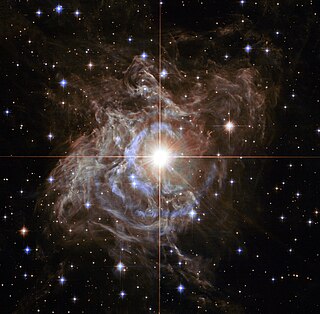
RS Puppis is a Cepheid variable star around 6,000 ly away in the constellation of Puppis. It is one of the biggest and brightest known Cepheids in the Milky Way galaxy and has one of the longest periods for this class of star at 41.5 days.

S Normae is a yellow supergiant variable star in the constellation Norma. It is the brightest member of the open cluster NGC 6087.

V636 Scorpii is a multiple star system in the constellation Scorpius, 3,000 light years away. The primary is a Classical Cepheid variable and its visual magnitude varies from 6.4 to 6.9.
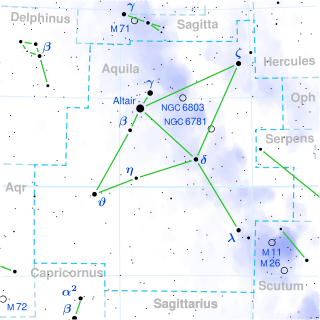
FF Aquilae is a classical Cepheid variable star located in the constellation Aquila, close to the border with Hercules. It ranges from apparent magnitude 5.18 to 5.51 over a period of 4.47 days, meaning it is faintly visible to the unaided eye in rural or suburban settings.

HR Carinae is a luminous blue variable star located in the constellation Carina. It is surrounded by a vast nebula of ejected nuclear-processed material because this star has a multiple shell expanding atmosphere. This star is among the most luminous stars in the Milky Way. It has very broad emission wings on the Balmer lines, reminiscent from the broad lines observed in the spectra of O and Wolf–Rayet stars. A distance of 5 kpc and a bolometric magnitude of −9.4 put HR Car among the most luminous stars of the galaxy.

V602 Carinae is a red supergiant and variable star of spectral type M3 in the constellation Carina. It is considered to be one of largest known stars, being around 1,000 times larger than the Sun.

AX Circini is a binary star system in the southern constellation of Circinus. It has a nominal magnitude of 5.91, which is bright enough to be visible to the naked eye. Based upon an annual parallax shift of 1.7 mas, it is located roughly 1,900 light-years from the Earth. The system is moving closer with a heliocentric radial velocity of −21 km/s.
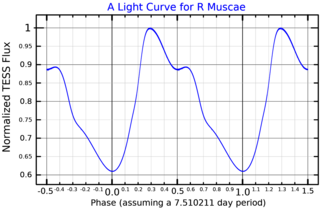
R Muscae is a yellow-white hued variable star in the southern constellation of Musca. It has a nominal apparent visual magnitude of 6.31, which is near the lower limit of visibility to the naked eye. The distance to this star, as determined from its annual parallax shift of 1.00 mas, is around 3,260 light years.
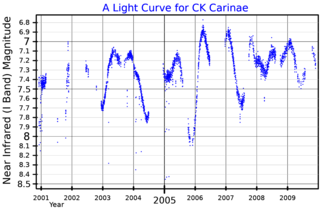
CK Carinae is a variable star in the constellation Carina, the keel of Argo Navis. It is a member of the star association Carina OB1-D, at a distance of around 2,300 parsecs or 7,500 light years.
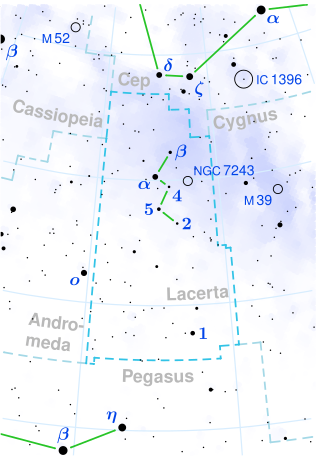
U Lacertae is a spectroscopic binary star in the constellation Lacerta.

Omega Geminorum, Latinized from ω Geminorum, is a star located in the middle of the northern zodiac constellation of Gemini. With an apparent visual magnitude of 5.18, it is faintly visible to the naked eye. According to the Bortle scale, it can be viewed from dark suburban skies. With an annual parallax shift of just 2.19 mas, it is located about 1,500 light years from the Sun.

V528 Carinae is a variable star in the constellation Carina.
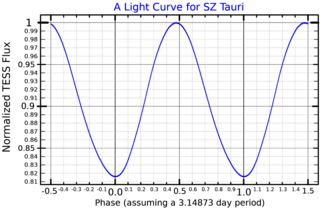
SZ Tauri is a variable star in the equatorial constellation of Taurus. The brightness of this star varies from an apparent visual magnitude of 6.39 down to 6.69 with a period of 3.149 days, which is near the lower limit of visibility to the naked eye. The distance to this star is approximately 2,070 light years based on parallax measurements. There is some indication this may be a binary system, but the evidence is inconclusive.


















